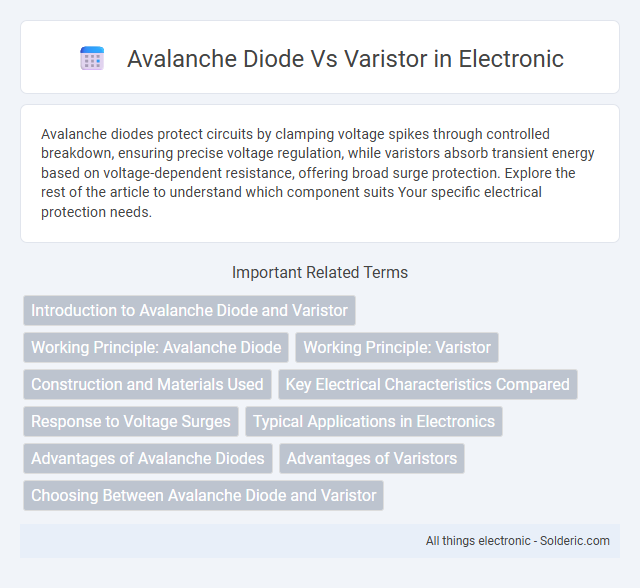Avalanche diodes protect circuits by clamping voltage spikes through controlled breakdown, ensuring precise voltage regulation, while varistors absorb transient energy based on voltage-dependent resistance, offering broad surge protection. Explore the rest of the article to understand which component suits Your specific electrical protection needs.
Comparison Table
| Feature | Avalanche Diode | Varistor |
|---|---|---|
| Function | Voltage-clamping device for transient voltage protection using avalanche breakdown. | Voltage-dependent resistor providing surge protection by changing resistance with voltage. |
| Material | Semiconductor (typically silicon). | Ceramic metal oxide (often zinc oxide). |
| Response Time | Fast, in nanoseconds. | Fast, in nanoseconds to microseconds. |
| Voltage Range | Precise clamping voltage specified by breakdown voltage. | Wide voltage range, non-linear resistance curve. |
| Applications | ESD protection, voltage transient suppression in sensitive circuits. | Surge protection in power lines, transient voltage suppression in electronics. |
| Durability | Good for multiple transient events if within limits. | Degrades after repeated high-energy surges. |
| Cost | Generally higher due to semiconductor processing. | Lower cost and simpler manufacturing. |
| Size | Small, suitable for compact circuits. | Varies, often larger than avalanche diodes. |
Introduction to Avalanche Diode and Varistor
Avalanche diodes are semiconductor devices designed to protect circuits by breaking down and conducting current at a specific reverse voltage, preventing damage from voltage spikes. Varistors, typically made from metal oxide, act as voltage-dependent resistors that clamp high transient voltages by changing resistance, safeguarding sensitive electronic components. Understanding these components enhances your ability to select the right surge protection for your electronic designs.
Working Principle: Avalanche Diode
Avalanche diodes operate by allowing current to flow through the breakdown of the p-n junction when the reverse voltage exceeds a specific threshold, known as the avalanche voltage. This breakdown occurs without damaging the diode, enabling it to protect circuits by clamping high-voltage spikes. Unlike varistors that rely on grain boundary conduction, avalanche diodes offer precise voltage regulation and rapid response time for safeguarding Your electronic components.
Working Principle: Varistor
A varistor operates by changing its resistance in response to voltage spikes, utilizing a nonlinear current-voltage characteristic that clamps excessive voltages and protects circuits by diverting surge currents. Unlike avalanche diodes that rely on the avalanche breakdown phenomenon in a semiconductor junction, varistors typically consist of metal oxide materials providing fast response to transient overvoltages. Your choice between these components depends on the specific surge protection requirements and the nature of the electrical disturbances you aim to mitigate.
Construction and Materials Used
Avalanche diodes are constructed using high-purity silicon with a p-n junction designed to break down at a specific reverse voltage, allowing controlled avalanche breakdown without damage. Varistors, typically made from zinc oxide (ZnO) grains sintered together with ceramic materials, exhibit nonlinear resistance characteristics due to the grain boundary interfaces. The differing materials and structures enable avalanche diodes to provide fast voltage clamping while varistors absorb high transient surges through energy dissipation.
Key Electrical Characteristics Compared
Avalanche diodes exhibit a precise breakdown voltage with rapid junction avalanche multiplication, allowing controlled voltage clipping and surge protection in high-frequency circuits. Varistors feature nonlinear voltage-current characteristics with a wide voltage clamping range, effectively suppressing transient voltage spikes across a broad energy spectrum. Your choice depends on the required response time, energy absorption capacity, and operating voltage accuracy for specific electronic protection needs.
Response to Voltage Surges
Avalanche diodes offer a precise and fast response to voltage surges by rapidly entering avalanche breakdown at a specified voltage, clamping the transient to protect sensitive components. Varistors respond to voltage surges by changing resistance non-linearly, absorbing large amounts of energy but with slower response times compared to avalanche diodes. The choice between avalanche diodes and varistors depends on the required clamping voltage accuracy and energy absorption capacity for effective surge protection.
Typical Applications in Electronics
Avalanche diodes are typically used in high-speed switching and voltage clamping applications to protect sensitive electronic components from transient voltage spikes. Varistors serve as voltage-dependent resistors commonly employed for surge protection in power supply lines, preventing damage from lightning strikes and power surges. Your choice depends on the specific application, with avalanche diodes favored in precise voltage regulation and varistors ideal for general overvoltage protection.
Advantages of Avalanche Diodes
Avalanche diodes provide precise voltage clamping with fast response times, making them ideal for protecting sensitive electronic circuits from transient voltage spikes. They offer superior repeatability and reliability compared to varistors, which can degrade after multiple surge events. Your circuit benefits from enhanced durability and exact voltage regulation using avalanche diodes in surge protection applications.
Advantages of Varistors
Varistors offer superior voltage clamping capability and faster response times compared to avalanche diodes, making them ideal for surge protection in electronic circuits. They provide excellent energy absorption and can handle high transient currents without damage, extending the lifespan of sensitive components. The nonlinear resistance of varistors enables effective suppression of voltage spikes, ensuring reliable circuit protection under fluctuating voltage conditions.
Choosing Between Avalanche Diode and Varistor
When selecting between an avalanche diode and a varistor for surge protection, consider the response time and voltage clamping characteristics; avalanche diodes offer precise voltage clamping with fast response ideal for sensitive electronic components, while varistors provide high energy absorption and are better suited for higher surge current situations. Your choice should depend on the specific circuit requirements, including the maximum surge voltage, energy rating, and tolerance to repetitive transients. Understanding these factors ensures optimal protection and longevity for your electronic devices.
Avalanche diode vs varistor Infographic

 solderic.com
solderic.com